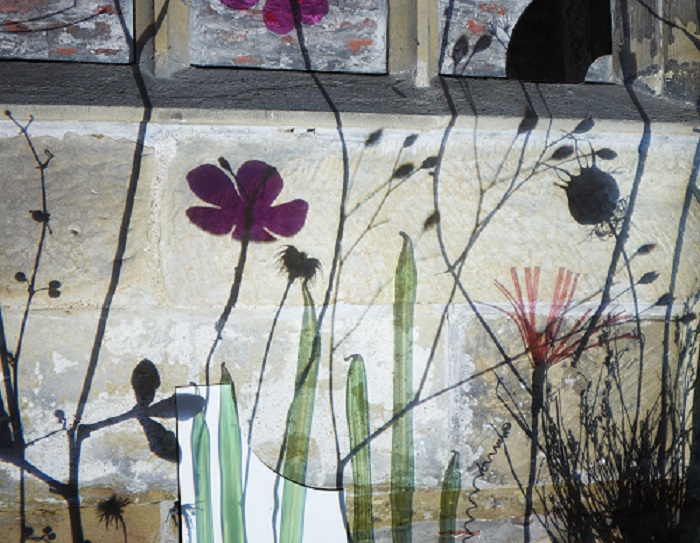| Helen Maurer re Composing |
 |
|
Helen Maurer re Connecting re Creation 2016 installation view at Illuminating York by Angela Moore |
|
Neal Brown Flowers from Helen |
|
Helen gave me some flowers when she came to my birthday party. I enjoyed them very much. I wrote and thanked her, saying I liked their ‘scented white beauty’. Helen told me she liked this description of them. Helen showed me around her installation entitled re Connecting re Creation shown at the Church of The Holy Trinity, in York, and subsequently at Danielle Arnaud, London. Whether they are one show, or two shows, is a point of discussion. The works remain the same at both installation sites, although the changed architectural context creates different values and responses. Both settings are architecturally resonant. The Church of The Holy Trinity, in York, which dates from the 12th Century, was the site of Helen’s first show of these works. It’s only used for services twice a year, but remains an emphatically religious building, rich with visual and social interest. Helen’s show there was part of Illuminating York, a programmed series of commissioned artworks involving the use of light, presented throughout the city centre. Danielle’s gallery is a private home in a particularly fine, period Georgian building. I like what I perceive as a flower theme in Helen’s shows. At which point, I need to remind myself what a flower is. A flower is the reproductive tissue of a plant. Many flowers have evolved so as to be attractive to animals, so that they may then transfer pollen and aid fertilisation. Flowers are valued by humans and used to visually enrich their environment, including as depictions in art. They have many other functions, such as the furtherance of love (and fertilisation), ritual and religion. They are associated with ideas of femininity, and what it is to be female. They are also used for medicine and food. After fertilisation, the ovary of the flower becomes fruit containing seeds. The duration of the reproductive process, in which the flower is fully expanded and functional, is called anthesis. Inflorescence, in a flowering plant, is the clustering of its flowers, categorised on the basis of their arrangement on an axis – number of flowers, positional relationships, etc – and by the timing of flowering. There is an unusual garden depicted high up in the stained glass at Holy Trinity, whose small scale and positioning hide it from easy perception. This small area of stained glass is valued by Helen for its intense, strange privacy. It seems to depict a paradise. Helen’s placement of her flower works is a similar kind of secret gardening, with growth and nurturing as spiritual analogues. In such ways it is possible for me to think of Helen’s shows as two gardens with the same flowers, in different stages of flowering and seasonal development, adaptive according to their environments. Whether within a church, projected onto an altar, or a fireplace hearth centered in Danielle’s Georgian house, Helen creates a garden ecology of flowers, plants, rainbows, winds, light and skies. It’s a wide habitat diversity. Her physical arrangement of the paper of the texts of the books seems to have some similarity with the inflorescence patterns of plants. And there is a dry, sometimes almost comedic tension in her work, including her use of books. Texts include My Prayer Book for Women and Girls (1) and a book on a music stand entitled The Illuminated Language of Flowers (2). Above these, Helen creates a flower/sun on the ceiling. Barley grows from the floorboards, blown by a gentle wind, originating from electric fans moving wind chimes. These are placed beneath a pew in Holy Trinity, and a cabinet in Danielle’s. Thus do the gallery and the church floors become seedbeds. Here is Helen’s own list of the objects she needs to create the works in these shows: Overhead projector with glass grass, dried plants
and acetate flowers x 4 Plants need starch, an energy-rich storage form of sugar, which they reserve for growth. Most of this material is a consequence of photosynthesis, which is the conversion of light energy from the sun to chemical energy. There is a kind of light synthesis going on in Helen’s work. It contains some of the paradoxes of stained glass which, you will remember, is perceived as chromatically radiant inside, but dull and almost monochrome outside. Helen makes arrangements of glass and objects on institutional overhead projectors, throwing a resulting magnificence of pure, coloured light onto architectural surfaces. This is in the context of whatever light is already inside, or enters into, the two buildings. Natural white light is reflected through the trees in the garden into Danielle’s, or comes through the stained glass at Holy Trinity. The various light sources, particularly at Holy Trinity, comprise a congregation. They include pure natural white light; light filtered chromatically through stained glass; primal light from burning candles; technical light from LED bulbs; the incandescent light from the halogen bulbs in Helen’s overhead projectors; fluorescent light from outside security lights; and the disheartening but useful municipal light from sodium street lights. The light energy of these translates into Helen’s psychic growth energy inside, and becomes a created beauty. Eventually the flowers that Helen gave me at my party perished, beginning with a slow discolouring. But it was a long expiry, and I was very grateful for their presence even while it was occurring. Thank you. NOTES 1 My Prayer Book For Women and Girls.
Tomkinson, H. London, 1935. Neal Brown is an artist and writer. He has written for most UK and many international art magazines, and is the author of a number of books about art. He curated To The Glory of God: New Religious Art at the second Liverpool Biennial. |
| >home |